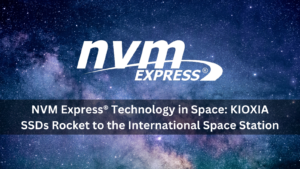
NVM Express® Technology in Space: KIOXIA SSDs Rocket to the International Space Station
BlogBy Cameron Brett, Sr. Director of Enterprise and Cloud Storage Marketing, KIOXIA and NVM Express MWG Co-Chair
Over the past decade, NVM Express® (NVMe®) technology has become the language of storage in the client, cloud and enterprise markets. Due to its high performance and scalability, NVMe technology has emerged across numerous applications and locations from AI/ML to IoT, and now even in space due to the efforts of NVM Express member companies KIOXIA and HPE.
KIOXIA has teamed up with HPE as part of the new HPE Spaceborne Computer-2 (SBC-2) program. The SBC-2 is the first-in-space commercial edge computing and AI-enabled system to run on the International Space Station (ISS) and is part of a mission to advance computing and reduce dependency on communications to transmit raw data as space exploration continues to expand. The technology offers many benefits like real-time image processing, deep learning and scientific simulations. Additionally, astronauts can process data directly on the ISS, eliminating the need to send raw data to Earth to be analyzed and the results sent back to space.
KIOXIA SSDs provided robust flash storage in HPE servers used in a test environment to conduct scientific experiments on the ISS. Thanks to the advanced features of NVMe technology, the NVMe SSDs offered the best power, performance and reliability needed for the experiments.
NVMe technology included in the SBC-2 enables the ISS to address many different use cases and workloads. The technology has also helped advance progress in healthcare, image processing, natural disaster recovery, 3D printing, 5G, AI and more.
To stay up to date on the latest NVMe technology use cases, follow us on LinkedIn and X/Twitter.